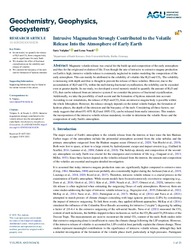Intrusive Magmatism Strongly Contributed to the Volatile Release Into the Atmosphere of Early Earth
DOI: https://doi.org/10.1029/2021GC010230
Persistent URL: http://resolver.sub.uni-goettingen.de/purl?gldocs-11858/10885
Persistent URL: http://resolver.sub.uni-goettingen.de/purl?gldocs-11858/10885
Supplement: https://doi.org/10.35003/MDMAJD
Vulpius, Sara; Noack, Lena, 2022: Intrusive Magmatism Strongly Contributed to the Volatile Release Into the Atmosphere of Early Earth. In: Geochemistry, Geophysics, Geosystems, Band 23, 12, DOI: 10.1029/2021GC010230.
 |
Dokument öffnen: |
Magmatic volatile release was crucial for the build‐up and composition of the early atmosphere and thus for the origin and evolution of life. Even though the rate of intrusive to extrusive magma production on Earth is high, intrusive volatile release is commonly neglected in studies modeling the composition of the early atmosphere. This can mainly be attributed to the solubility of volatiles like H2O and CO2. The solubility is increasing with depth and thus is thought to prevent the release of these volatiles. However, due to the accumulation of H2O and CO2 within the melt during fractional crystallization, the solubility can be exceeded even at greater depths. In our study, we developed a novel numeric model to quantify the amount of H2O and CO2 that can be released from an intrusive system if we consider the process of fractional crystallization. Additionally, we take the possibility of melt ascent and the formation of hydrous minerals into account. According to our simulations, the release of H2O and CO2 from an intrusive magma body is possible within the whole lithosphere. However, the release strongly depends on the initial volatile budget, the formation of hydrous phases, the depth of the intrusion and the buoyancy of the melt. Considering all these factors, our study suggests that about 0%–85% H2O and 100% CO2 can be released from mafic intrusions. This renders the incorporation of the intrusive volatile release mandatory in order to determine the volatile fluxes and the composition of early Earth's atmosphere. Key Points:
In our model, we quantify the release of H2O and CO2 from a magma body and its significance for early Earth.
We examine the effect of fractional crystallization on the solubility and release of volatiles.
We consider the buoyancy of the melt and the formation of hydrous minerals.
Statistik:
ZugriffsstatistikSammlung:
Schlagworte:
volatile releaseintrusive magmatism
fractional crystallization
early Earth
atmosphere
solubility
This is an open access article under the terms of the Creative Commons Attribution License, which permits use, distribution and reproduction in any medium, provided the original work is properly cited.

